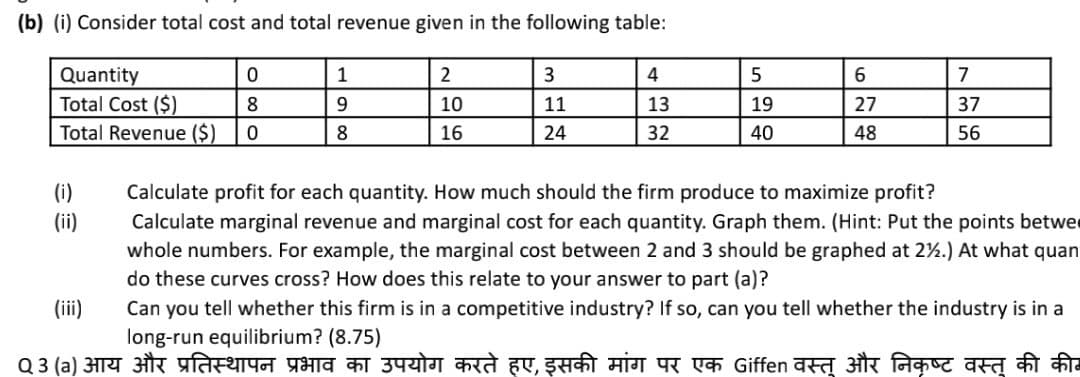(b) (i) Consider total cost and total revenue given in the following table: Quantity Total Cost ($) 1 3 4 6. 7 8 9. 10 11 13 19 27 37 Total Revenue ($) 8. 16 24 32 40 48 56 (i) Calculate profit for each quantity. How much should the firm produce to maximize profit? (ii) Calculate marginal revenue and marginal cost for each quantity. Graph them. (Hint: Put the points betwe whole numbers. For example, the marginal cost between 2 and 3 should be graphed at 2%.) At what quar do these curves cross? How does this relate to your answer to part (a)? Can you tell whether this firm is in a competitive industry? If so, can you tell whether the industry is in a long-run equilibrium? (8.75) (ii)
(b) (i) Consider total cost and total revenue given in the following table: Quantity Total Cost ($) 1 3 4 6. 7 8 9. 10 11 13 19 27 37 Total Revenue ($) 8. 16 24 32 40 48 56 (i) Calculate profit for each quantity. How much should the firm produce to maximize profit? (ii) Calculate marginal revenue and marginal cost for each quantity. Graph them. (Hint: Put the points betwe whole numbers. For example, the marginal cost between 2 and 3 should be graphed at 2%.) At what quar do these curves cross? How does this relate to your answer to part (a)? Can you tell whether this firm is in a competitive industry? If so, can you tell whether the industry is in a long-run equilibrium? (8.75) (ii)
Microeconomics: Private and Public Choice (MindTap Course List)
16th Edition
ISBN:9781305506893
Author:James D. Gwartney, Richard L. Stroup, Russell S. Sobel, David A. Macpherson
Publisher:James D. Gwartney, Richard L. Stroup, Russell S. Sobel, David A. Macpherson
Chapter11: Price-searcher Markets With High Entry Barriers
Section: Chapter Questions
Problem 14CQ
Related questions
Question
Consider total cost and total revenue given in the following table:
TABLE IN IMAGE
Calculate profit for each quantity. How much should the firm produce to maximize profit?
(ii) Calculate marginal revenue and marginal cost for each quantity. Graph them. (Hint: Put the points between
whole numbers. For example, the marginal cost between 2 and 3 should be graphed at 2½.) At what quantity
do these
(iii) Can you tell whether this firm is in a competitive industry? If so, can you tell whether the industry is in a
long-run equilibrium? (8.75)

Transcribed Image Text:(b) (i) Consider total cost and total revenue given in the following table:
Quantity
Total Cost ($)
Total Revenue ($)
1
4
6
7
8
10
11
13
19
27
37
8
16
24
32
40
48
56
(i)
Calculate profit for each quantity. How much should the firm produce to maximize profit?
(ii)
Calculate marginal revenue and marginal cost for each quantity. Graph them. (Hint: Put the points betwe
whole numbers. For example, the marginal cost between 2 and 3 should be graphed at 2%.) At what quan
do these curves cross? How does this relate to your answer to part (a)?
Can you tell whether this firm is in a competitive industry? If so, can you tell whether the industry is in a
long-run equilibrium? (8.75)
(ii)
Q3 (a) आय और प्रतिस्थापन प्रभाव का उपयोग करते हुए, इसकी मांग पर एक Giffen वस्तु और निकृष्ट वस्तु की की
Expert Solution
This question has been solved!
Explore an expertly crafted, step-by-step solution for a thorough understanding of key concepts.
This is a popular solution!
Trending now
This is a popular solution!
Step by step
Solved in 4 steps with 3 images

Knowledge Booster
Learn more about
Need a deep-dive on the concept behind this application? Look no further. Learn more about this topic, economics and related others by exploring similar questions and additional content below.Recommended textbooks for you

Microeconomics: Private and Public Choice (MindTa…
Economics
ISBN:
9781305506893
Author:
James D. Gwartney, Richard L. Stroup, Russell S. Sobel, David A. Macpherson
Publisher:
Cengage Learning

Economics: Private and Public Choice (MindTap Cou…
Economics
ISBN:
9781305506725
Author:
James D. Gwartney, Richard L. Stroup, Russell S. Sobel, David A. Macpherson
Publisher:
Cengage Learning


Microeconomics: Private and Public Choice (MindTa…
Economics
ISBN:
9781305506893
Author:
James D. Gwartney, Richard L. Stroup, Russell S. Sobel, David A. Macpherson
Publisher:
Cengage Learning

Economics: Private and Public Choice (MindTap Cou…
Economics
ISBN:
9781305506725
Author:
James D. Gwartney, Richard L. Stroup, Russell S. Sobel, David A. Macpherson
Publisher:
Cengage Learning


Principles of Economics 2e
Economics
ISBN:
9781947172364
Author:
Steven A. Greenlaw; David Shapiro
Publisher:
OpenStax

Essentials of Economics (MindTap Course List)
Economics
ISBN:
9781337091992
Author:
N. Gregory Mankiw
Publisher:
Cengage Learning